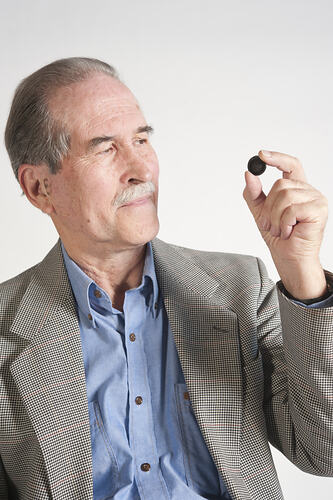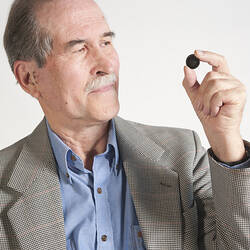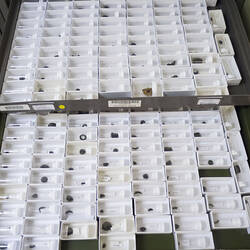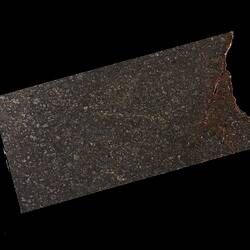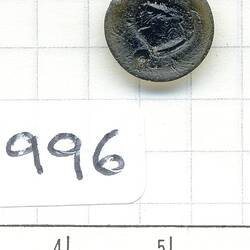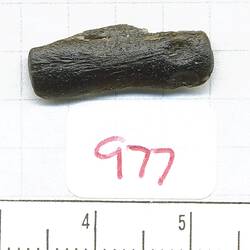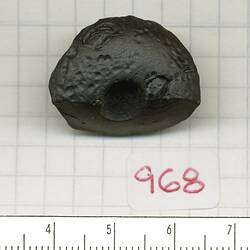'My interest started at the age of seven when I found an amethyst in a quartz pebble. I always had my eye on the ground. That's how it started' (Ralph and Herta Uhlherr, 2015, Interview).
In 1934, Ralph Uhlherr was born into a Templer community in Jaffa, Palestine. However, because of British mandate, Templers were expelled from Palestine during and after World War II. This was the start of an incredible migration for Ralph and his parents that eventually led them to Australia. Ralph mentions, that in the last leg of the journey he got to stand between the two Australian pilots flying the plane (DC-3) he was on and, in an interview, he fondly recalls those pilots' antics,
'.he suddenly switched off the automatic pilot and pulled on the joy-stick. I got scared and said, "What happened?" He said, "The Equator. We jumped across the Equator' (Ralph and Herta Uhlherr, 2015, Interview).
Though Ralph chose engineering as a profession, his interest in meteorites and tektites was a constant companion in his life. Museum Victoria, then the National Museum of Victoria, played a role in fueling his interest by providing him with avenues of research so that he could learn about meteorites and later, tektites and australites. The Museum's collection of George Baker's australite illustrations from Port Campbell provided beautiful photos to look at and exact locations where specimens could be found.
Backed by the information he had gathered, Ralph found his first australite in 1974. He started travelling three or four times a year with his young family and wife, Herta Uhlherr, to Port Campbell, looking for australites. Through hot, cold or wet weather, his family helped him collect. Herta mentions that the children had special motivation to go tektite hunting because 'if they found something good, Dad would buy it off them' (Ralph and Herta Uhlherr, 2015, Interview).
As a result of Ralph's collecting, he also become active in geological and astrogeological circles. In 1987, Ralph met Eugene M. Shoemaker, meteorite and asteroid crater expert, who he recognised from pictures in scientific journals he had read. Ralph recalls walking straight up to Gene Shoemaker, introducing himself and saying how impressed he was with his papers and work on impact craters. That meeting was the start of a fruitful collaboration and friendship, the results of which were a co-authored article in the journal Meteoritic & Planetary Science, world-wide exposure of the H.R Uhlherr tektite collection and Eugene and Carolyn Shoemaker naming an asteroid after Ralph.
Ralph has many memories of collecting over the years but he mentions the 'thrill of finding a perfect button sticks out like a sore thumb' (Ralph and Herta Uhlherr, 2015, Interview). The first member of the Uhlherr family to find a perfect button was Belinda, Ralph and Herta's eldest. Everyone else found beautiful dumbbells, ladles and fragments but she found a perfect button long before the others.
Ralph sold his tektite collection to Museum Victoria in February 2011. The H.R Uhlherr collection combined with the George Baker collection make up half of Museum Victoria's whole holdings of tektites. The tektites of both these collections were found in the Port Campbell area, making Museum Victoria the custodians of the best Port Campbell/Peterborough australite collection world-wide.
Although Ralph has retired from active collecting, he hopes that his tektite collection at Museum Victoria will help future scientific studies prove (or disprove) areas of controversy in the field.
Publications
Shoemarker, E. & Uhlherr, H.R. (1999). Stratigraphic relations of Australites in the Port Campbell Embayment, Victoria. Meteoritic & Planetary Science, 34: 369 - 384
References
Memories in my luggage. (2015) Stargazing, meteors and australites - Hermann Ralph Uhlherr. Retrieved from http://www.memoriesinmyluggage.com.au/news/stargazing-meteors-and-australites-hermann-ralph-uhlherr
Interview with Hermann Ralph and Herta Uhlherr, 16 July 2015, 1:16:40
More Information
-
Keywords
-
Authors
-
Article types
